Strategies to Max Out Maximum Permitted Mileage (MPM)
It’s no secret that I love to get the most out of my award tickets, and that includes maximum permitted mileage or (MPM). I also am a big fan of sub 23 hour layovers and wrote articles this summer detailing some of the best cities for that in Asia, North America and Europe (and made a database that catalogs airport transfer and luggage storage options for 108 of them).
So I thought it might be helpful to show how many parts of the world are actually very much on the way to each other. It’s just a matter of ditching the notion of a mercator projection (or similarly rectangular) map.
Your Standard Mercator Projection Map
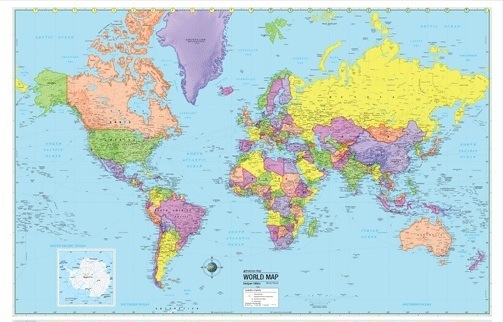
Your standard mercator projection map. But hey! It’s a rectangle and fits neatly on a wall!
We’ve all grown up accustomed to rectangular (usually Mercator projection as it minimizes distortion) maps, hung in schools, offices and government buildings.
So while we internalize this view of the world, it completely obfuscates how great circle routes work. Even though the world is a ball, we treat it like a two dimensional rectangle, we’re bound to get some estimations of distance and directions off.
That’s why I want to show a few orthographic projections (fancy term for “staring from a right angle at whatever you’re looking at / i.e. head on”). The world will look like a circle and you only see half of it, but any line going through the center will approximate a great circle route and be the most direct possible way to get from point A to point B. Also, if two cities are roughly across from each other at the edge of the map, they are effectively 12,000 miles apart (antipodes) and ANY route in any direction will be “the most efficient.”
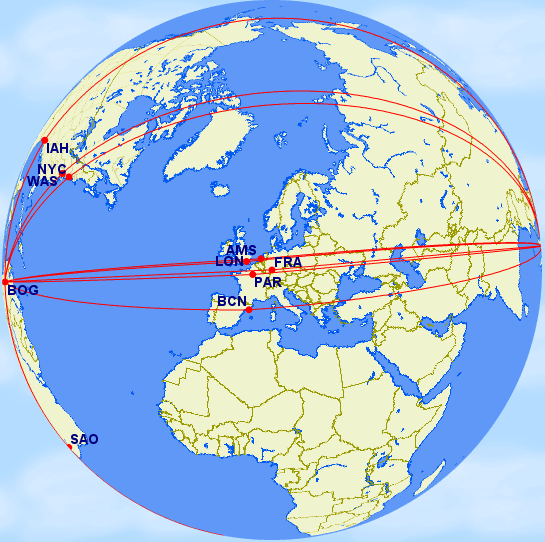
Bogota and Singapore, both being almost exactly on the equator at 12,000 miles apart have infinite equidistant routes between them. (Courtesy: gcmap.com)
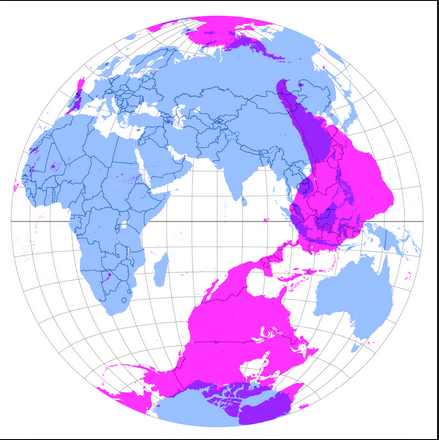
Here’s a handy map that shows you the antipodes for everywhere on Earth. South America and East Asia overlap pretty nicely, as do New Zealand and Spain.
Keeping our hobby in mind, remember that there are a few mileage programs out there that price award based on the mileage covered by the entire ticket AND offer a number of stopovers along the way.
Others also allow you to exceed MPM by 5% (Aeroplan) or 25% (American). Delta generally keeps to MPM, US and United do not.
Also remember that airlines specify a maximum permitted mileage that you must keep your trip under to be valid, otherwise you could connect anywhere to get to your destination. Typically IATA lists a few values calculated by looking at connectivity between two points.
Useful Terms - Find on Expertflyer under Travel Information->Maximum Permitted Mileage

Here’s IATA’s TPM and MPM between Bogota and Singapore. Note that while the most efficient route would be 12,015 miles. You can actually fly an additional 2400 miles (or roughly 20% deviation) more than this. Or pick any two cities within 1200 miles of SIN and/or BOG and fly to them as well without breaking the MPM. (Courtesy: Expertflyer.com)
TPM = Ticketed Point Mileage - Typically this is the mileage between two points taking the most direct connections
MPM = Maximum Permitted Mileage - The maximum distance after adding up all segments
So here’s some cool things you can do, once you begin to think orthographically (if you already anticipate the arctic swings that fight paths take on rectangular maps, you’re on your way there).
Most of Northeast Asia is in play from North America to Southeast Asia
Here’s a map centered on Tokyo (NRT):

Here’s a number of routes between North America and Southeast Asia passing through Tokyo. Note that you could hit nearly any (in some case several) of the highlighted cities and still not break MPM to Singapore or Denpasar/Bali. In other words, Japan, Korea and Eastern China are on the way to anywhere in in East Asia (Courtesy: gcmap.com)
You can see that Tokyo and to a lesser extent Seoul is on the way from anywhere in North America to anywhere in Southeast Asia. More importantly, look at all of the major hubs that have direct flights to the US (PEK, PVG, HKG, TPE) that are still pretty much in line. You could stop in several without breaking the MPM or distance based mileage limits.
All of Europe is on the way to the Middle East
Similarly, departing from anywhere in North America to anywhere in the Middle East or India, you’ll likely be able to stop ANYWHERE in Europe and not exceed the maximum permitted mileage (typically around 20% more than the most direct route).
Here’s a map centered on Frankfurt. Remember that lines going through the middle are Great Circle Routes and therefore the absolute shortest way between point A and B. New York to Dubai passes nearly directly over Frankfurt. This is also why the Emirates flight stops in Milan along the way. It’s not just an Emirati appreciation for high fashion!
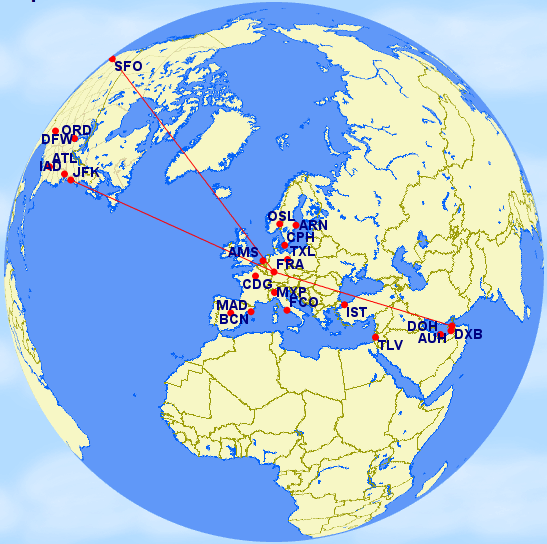
Going to the Middle East or India, you could stop in any of a dozen cities in Europe (why not two or three?) on the way and still not break MPM (Courtesy: gcmap.com)
Most of the Caribbean, Central America and Northern South America is on the way to Brazil, Argentina and Chile.
Again, looking at flights heading to Santiago, Buenos Aires or parts of Brazil:
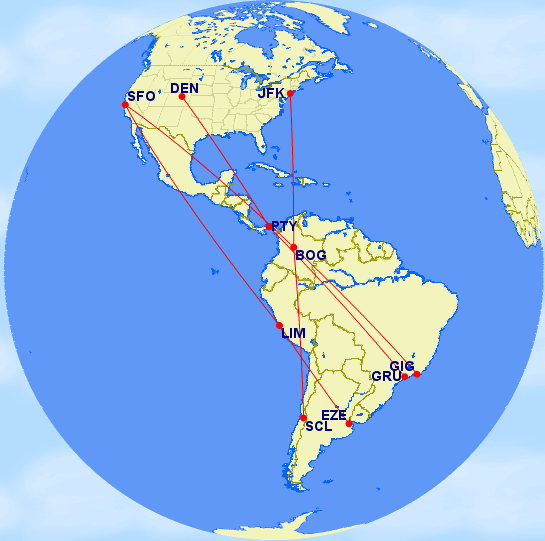
Even though we’re centered on Bogota, I’m trying to show that there are logical stops in Panama City, Bogota or Lima that aren’t going to dramatically count against maximum permitted mileage, due to the continent being shifted east of North America. (Courtesy gcmap.com)
Keep in mind that AA does not allow transiting via Northern South America to get to Southern South America, but almost every other program does.
You can also do some cool things like layer tickets within each other. Those Avios will be able to get you all over Peru and Colombia on the cheap. You could also leave a huge stopover in say Bogota, stay for a bit, head home on another ticket and pick up the stopover later in the year. Region-based programs are generally the best to get you to a far-flung region, but distance-based programs may allow you to see a ton once there.
Direct Flights Don’t Count Against MPM
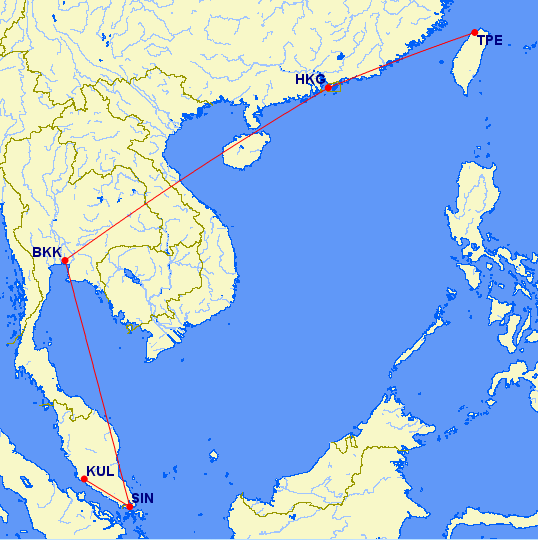
This was a valid routing from Kuala Lumpur to Taipei because of a direct flight from Singapore to Hong Kong via Bangkok. I stopped in SIN and HKG for a day each to visit friends using AA miles without breaking the MPM or any other routing rules. (gcmap.com)
You can also take advantage of “direct” flights to maximize your time in the air. Since the flight I took from Singapore to Bangkok to Hong Kong retained the same flight number, the distance counted against MPM was SIN-HKG as the crow flies (as if I never went to BKK)
Ok so why does this matter? Use region-based programs for short layovers, distance-based for long ones
For each program, there are different ways to exploit this.
For region-based programs, understand the routing restrictions in place — then have a field day! Generally, you can hop amongst regions unless it’s expressly forbidden, so a quick layover in your home region, transiting region or destination region is totally on the table. Grab coffee in Vienna or Bogota or Seoul on your way to somewhere else. Ben talks about what regions using AA miles can be transited on the way to other continents and Drew has done a fantastic job slicing the Gordian knot that is United region pricing engine.
For Delta, Alaska, Singapore, LH, Air Canada Aeroplan and Taca/Avianca Lifemiles, you’re generally allowed to price anything under the MPM and under the maximum number of segments permitted, at least that’s what the computer is checking.
Some may list that backtracking is not allowed, but it’s pretty subjective (and remember that your phone agent likely has a similar “rectangular” understanding of geography and will likely only think of things in East-West terms.)
Obviously, for distance-based programs, you’d want to maximize out the band your were going to use anyway and take as many stopovers as you are allowed. If you have the stamina for a megatrip, try not to leave any on the table. I would highly recommend picking a “dense” region for destinations, namely Europe, East Asia or the Caribbean/Central America and taking advantage of a local partner that hubs there. Cathay, ANA, Air China, Air Berlin, LH Group, Copa, Taca/Avianca and LAN/TAM would all make excellent candidates to zigzag around a region without eating up too much available mileage.
These are especially cool since stopovers don’t restrict you to staying under 24 hours in a transit city.
ANA Distance-based Chart (Transfer partner of Starwood Preferred Guest and Membership Rewards):
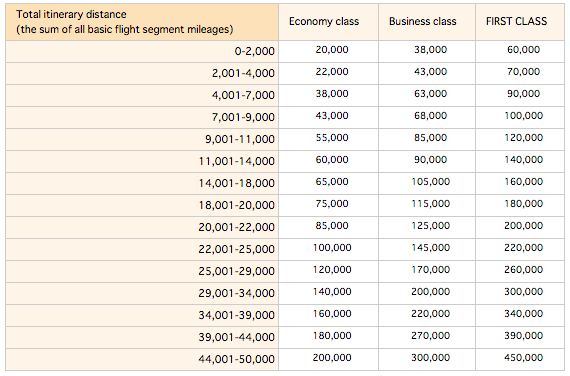
Remember that the 4001-7000 miles and 7000-9000 miles bands in business class are sweet spots, but given recent devaluations other larger bands are starting to look really attractive to hop around Europe, East Asia or the Caribbean on Star Alliance. Keep in mind that ANA doesn’t charge fuel charges for Western Hemisphere-based carriers and allows up to 4 stopovers.
Cathay Distance Based Chart (requires three-airline itineraries including Cathay or two-airline itineraries not including Cathay) - Transfer partner of Citi Thank You Points and Membership Rewards:
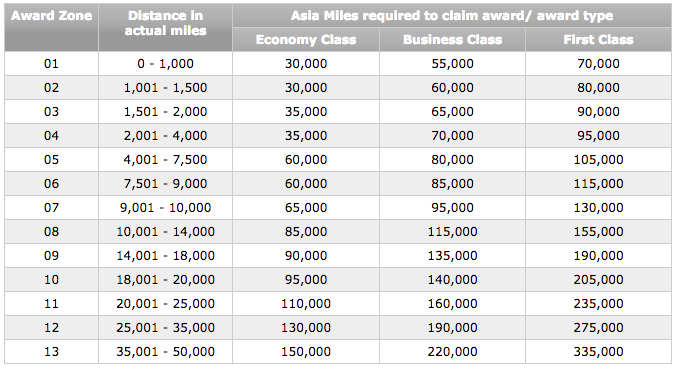
Here you can get 5 stopovers and 2 open jaws. Pick two carriers and don’t include Cathay (again, really useful to South America or the Middle East) and you could bake in a serious vacation to a lot of destinations. Remember that Western Hemisphere airlines, Iberia and Air Berlin don’t tend to have huge fuel surcharges.
JAL Mileage Bank - oneworld chart <among many> (Transfer Partner of Starwood Preferred Guest)

The story is similar for JAL, though take a look at the various regional charts to ensure the award costs as much as you think it does. It’s also one of the few airlines that partners with Emirates.
Malaysia Airlines Distance Chart (Transfer partner of Citi Thank You Points)

Less lucrative, but hey! they transfer from Citi Thank You Points!
I am a little curious what damage could be done on some of these 50,000 mile bands for 220,000 miles. You could hit some pretty far flung places for that kind of change (really, we’re talking two boring roundtrips to Europe otherwise)
Conclusion
While a lot of people want to minimize connections and maybe don’t have enough vacation time to explore more than one destination (there’s room for an entire series of posts on this), it’s important to make your layovers work for you. Recover from jetlag more easily, sample a different climate or cuisine or plan multiple trips using parts of the same ticket.
Most people think they’re going due west over the Pacific, over Africa on the way to the Middle East or due south on the way to South America, based on how we were raised to think about maps. But the world is throwing us a bit of a curve ball so to speak and many of our favorite cities may fall directly in line with each other.
I hope this post helps you think about how to cherry pick the advantages of distance-based and region-based programs and to plan your trips not only with just the destination in mind. Those curvy lines are cool on the inflight entertainment screen, but I’d much rather be sipping coffee in Vienna than flying a 15 hour flight over it!
Comments, corrections and other tips are appreciated!

Extremely informative and well done. Thank you!
Excellent post. I really enjoy reading your blog. One of the best out there. Thank you.